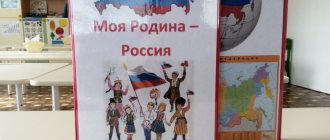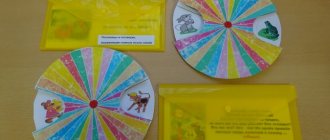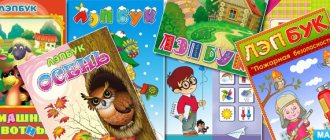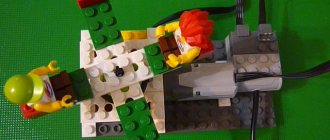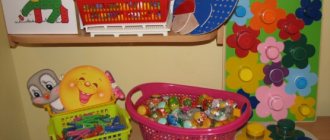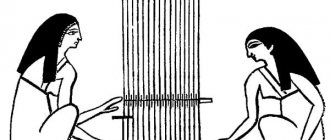What is a lapbook
A laptop is the newest way to organize educational activities with preschoolers. This is play, creativity, learning new things, repeating and consolidating what has been learned, systematizing knowledge, an interesting type of joint activity between the teacher and the child.
The meaning of a lapbook
The methodological manual Lapbook “Entertaining Mathematics” in secondary school was developed with the goal of children mastering mathematical methods of cognition, using educational games, in order to ensure the activity of mental and practical activity in the process of independent and joint activity of preschoolers and adults.
At the first stage, the child is taught to correctly navigate in space, that is, to react to the following moments: left, right, top, bottom, center, above, below, between, clockwise. Over time, the tasks become more difficult.
Note! Already in the fourth year, the child begins to solve addition/subtraction problems, and also consolidates the representation of a number from two smaller ones.
Lapbook “Fun Math”
Lapbook "Fun Math"
Author: teacher: Svetlana Valerievna Fedotova
The reform of the preschool education system, in connection with the introduction of the Federal State Educational Standard, forces us to reconsider the targets established in theory and practice; content, methods, forms of work with children, requirements for a developing subject-spatial environment. The introduction of the standard included teachers in an active search to meet modern requirements for the education and upbringing of preschool children. I was interested in the technology of making laptops. What attracted you to this technology? Firstly, the laptop meets the requirements of the Federal State Educational Standard for preschool education for a spatial subject-development environment:
Transformability: a lapbook allows you to change the space depending on the educational situation, including the changing interests and capabilities of children.
Multifunctionality: using the folder in various types of children's activities, the lapbook can be used in working with the whole group, or with a subgroup of children, as well as in individual work with children.
Variability: periodic change of gaming material, ensuring free choice of children, the emergence of new materials that stimulate children’s activity;
Accessibility: the lapbook ensures accessibility for all children, the possibility of its use in any room where educational activities are carried out, including in the walking area of the preschool educational institution.
Saturation: corresponds to the content of the educational program, developed on the basis of one of the sample programs, and also corresponds to the age characteristics of children, that is, in one folder you can place a lot of information on a certain topic, rather than selecting various didactic material.
Safety presupposes the compliance of all its elements with the requirements to ensure the reliability and safety of their use.
Lapbook “Fun Math”
I would like to present to your attention my lapbook “Entertaining Mathematics”, which helps children form logical and mathematical concepts, increase the activation of thought processes, and develop sensory ways of cognition. Based on modern educational technology, games collected in a laptop can be used in organizing a joint educational game situation, in monitoring, as well as in individual work with children. The purpose of creating a lapbook for the formation of mathematical concepts is for children to master mathematical ways of knowing using educational games. In my work on creating a lapbook, I pursued the following goals:
1. improve children’s knowledge about geometric shapes;
2. fix the score within 10;
3. consolidate addition and subtraction skills;
4. consolidate the concepts “<”, “>”, “=”;
5. develop logical thinking, visual memory, imagination, fine motor skills;
6. cultivate independence, the ability to understand the educational task.
The lapbook includes:
1.Book “Mathematical Poems”
Purpose: serves for better memorization of numbers by children
2. Book “Math problems”
Goal: train memory, develop logical thinking and lift your spirits!
3. D/I “Put the picture together”
Goal: development of visual memory and attention. The game consists of mathematical puzzles (changeable depending on the theme of the week, time of year) that teach counting in the range of 10-20. In order to get a picture you need to collect strips with numbers in order
4. D/I “Place a figure from counting sticks”
Goal: development of logical thinking and fine motor skills.
5. D/I “Find your neighbors”
Target. Strengthen children's knowledge of numbers and the ability to name neighbors of numbers. Develop memory and attention.
6. D/I “Number houses”
(fix the composition of the number within 10). Goal: developing knowledge about the composition of a number from two smaller ones.
7. D/I “Arrange the signs”
Goal: to consolidate the ability to correctly use comparison signs
8. D/I “Name the color, shape and quantity”
Goal: to develop the ability to distinguish geometric shapes: rectangle, triangle, square, circle, oval and name the color and number of shapes depicted on the sheet.
9. “Chain of Examples”
Purpose: to exercise the ability to perform arithmetic operations
10. “Math coloring pages
» Goal: to consolidate the ability to solve examples within 10. Select a color that corresponds to a certain number.
11. “Graphic dictation”
Goal: to promote the development of spatial imagination, fine motor skills of the fingers, coordination of movements, perseverance.
12. D/I “Count the objects
» Goal: learn to count objects on a card and indicate the number of objects with a number.
13. D/I “Write down and solve the problem”
Goal: To strengthen in children the ability to perform simple arithmetic operations for addition and subtraction.
14. "Labyrinths".
Goal: to promote the development of logical and spatial thinking, the ability to achieve goals, to promote the development of perseverance and patience.
15. “How to write numbers correctly”
The goal is to form a graphically correct, clear and fairly quick letter
My math laptop contained a lot of information in an attractive and interesting way. While playing with a laptop, children complete tasks and learn to think, develop attention, memory, logical thinking, visual perception, fine motor skills, imagination, and curiosity.
Each teacher can make it in his own way, on any topic and, most importantly, together with the children. Children treat the product of their creativity very carefully and proudly tell and show it.
Such an unusual presentation of the material will definitely attract the child’s attention, and he will return to this folder more than once to look through it, play with it, and at the same time, unbeknownst to himself, repeat the material he has covered.
Presentation Lepbook “Entertaining Mathematics” PPTX / 9.22 MB
What should a math lapbook be like for preschoolers?
Spatial orientation is of universal importance for all aspects of human activity. This term includes various aspects of his interaction with reality. The human psyche is formed from this meaning.
Which math lapbook to choose for preschoolers
Note! Touching all areas of a preschooler’s interaction with any reality, spatial orientation has a beneficial effect on the child’s psyche. Already in the fourth or fifth year of life, the child develops self-awareness, as well as personal qualities. All these phenomena are part of the socialization process.
Lapbook for mathematics senior group is an assistant in:
- understanding and remembering information on the topic being studied;
- the child acquiring the skills to independently collect and organize information on the topic being studied;
- repetition and consolidation of material on the covered topic.
Psychological and pedagogical conditions for the implementation of the basic educational program of preschool education are one of the most important conditions. The teacher’s task is to develop children’s curiosity, their desire to explore this world. It is necessary to be able to choose adequate forms of pedagogical support for each child.
Play is the main and leading activity of preschool children. The preschool educational institution's laptop will help the teacher create conditions for free children's play. This manual is a visual and practical teaching method that meets modern requirements for organizing a subject-spatial developmental environment in the context of the implementation of the State educational standard for preschool education.
Cognitive and speech development of preschool children
The educational institution believes that this teaching aid Lapbook “Entertaining Mathematics” is intended for children 4-6 years old.
Expected Result:
- increasing cognitive interest in children;
- effective assimilation of information and consolidation by students of what they have learned in an interactive, entertaining and playful form;
- development of mathematical and communication abilities.
Note! The novelty of the proposed manual is that the use of a lapbook ensures equality of opportunity and the full development of every child. By combining teaching and upbringing into a holistic educational process, a lapbook allows the teacher to build activities based on the individual characteristics of each child, to create conditions under which the child himself becomes active in choosing the content of his education.
For the older group
The main goal of this technique is to create all kinds of conditions so that they are aimed at the formation of spatial representations. During the work, children consolidate and expand their spatial representations: left, right, above, below, in front (in front, behind, next to), and also develop the ability to navigate on a sheet of paper. Every kindergarten teacher should teach preschoolers to indicate in speech the position of one or another object in relation to themselves and another object.
Senior group
Important! The educational program for the senior group is aimed at developing visual-spatial orientation in children. This leads to the development of speech, thinking, and intelligence.
For the middle group
A mathematics laptop for the preparatory group serves to form a logical-mathematical understanding, increase the activation of the thinking process, and develop sensory methods of cognition. For this purpose, kindergarten teachers use educational games. for example, you can consider a didactic game called “Learning numbers.”
Middle group
The main goal of the lesson for the fourth year is to introduce children to the images of numbers in poetry. They learn to understand, develop memory and thinking.
For the preparatory group
A laptop for FEMP in the preparatory group develops logical thinking, attention, and memory of the child. It is much easier to remember the material in a playful way. For example, a math lapbook on the topic “Mathematics Lives Here” is being considered. It acts as a house, which has a certain plot, including the main characters. Among them, “Numbers” stand out. The child's preschool age ranges from 4 to 6 years.
Preparatory group
The main goal is to repeat and consolidate the material covered in mathematics in a playful way. By solving problems on this topic, preschoolers’ knowledge of geometric shapes is improved, counting is consolidated up to 10. Special material is prepared for the work:
- colored paper,
- glue,
- plastic folder,
- satin ribbon,
- magnet,
- tulle,
- beads,
- foamiran.
Drawing classes for children 2-3 years old - teaching the baby
Math laptops
Contained in sections:
- Lapbook. Lapbooks on all topics 7376
- Mathematics. Mathematical representations, FEMP 33376
Showing publications 1-10 of 273. All sections | Mathematics. Math laptop
New
Photo
The best
Lapbook “Fun Math” for middle and older ages
LAPTOP "Fun
Mathematics " (middle and older age)
Objectives: *Develop children's cognitive interests *Expand the experience of orientation in the environment *Develop sensory knowledge,
mathematical properties *Develop curiosity, cognitive motivation *Develop perception, ...
Lapbook "Fun Mathematics" for primary preschool age
“Fun Mathematics
laptop helps children of primary preschool age to form logical and mathematical concepts , increase the activation of thought processes, and develop sensory ways of cognition. “Fun Math laptop is intended for additional, group…
Passport of the methodological manual “Lapbook “Who, who lives in the little house?”
Passport of the methodological manual “Lapbook”
“Who-who lives in the little house?”
General description.
Lapbook “Who, who lives in the little house?” is a 2-page themed interactive folding folder. It is made of thick cardboard using self-adhesive film, colored cardboard, illustration material; on the pages of the folder there is a notepad on a spring, baby books, transparent envelopes that contain information on the topic.
Guidelines.
The laptop is intended for children of senior preschool age. An adult should familiarize the child with the rules of the games and play with them. During didactic games, an adult must stimulate the child’s speech activity and encourage correct answers. Having mastered the rules, children can then play on their own.
Target.
Expand, deepen, and systematize children’s knowledge about wild animals (appearance, what they eat, name of home, ability to recognize and name animals and their young). Cultivate an interest in living nature.
The following games are included in this tutorial.
1 Game "Labyrinths"
Target:
develop the tracing function of the eye, attention, patience, memory; practice recognizing and naming young wild animals, reinforce, and teach comparisons of animals based on their feeding patterns.
Material:
pictures with intricate paths, following which the child will find the exit of the path with a pencil.
Form of activity:
together with an adult, independent play for children.
2 Game “Me and My Friends”
Target:
teach comparison of contour, silhouette images of wild animals and correlate them with real images; develop visual perception, memory, attention.
Material:
The game is presented in the form of a small book, in the pocket there is a set of cards depicting contour, silhouette and real images of wild animals.
Form of activity:
joint with a teacher or with peers, independent play.
3 Game “Collect the picture”
Target:
form an idea of a holistic image of an object; learn how to correctly assemble an image of an object from separate parts; correlate the image of the representation with the holistic image of the real object.
Material:
a pocket containing 1 set of cards with images of drawn animals and 2 sets of cut cards.
Form of activity:
together with an adult, independent play for children.
4 Game “Pick up my fur coat”
Target:
learn to compare animals by appearance, consolidate knowledge of the basic colors of the spectrum and their shades.
Material:
1 set of cards with the outline of the animal, 2 sets of colored cards corresponding to the color of the animal’s fur.
Form of activity:
together with an adult, independent play for children.
5 Game “Obedient Fingers”
Target:
develop hand-eye coordination, orientation skills in microspace, attention.
Material:
a notebook on a spring in which children are given tasks (circle the dots, connect the dots by numbers, shade the fur coat).
Form of activity:
together with an adult, independent play for children.
6 Game “Hide the Animal”
Target:
consolidate children's knowledge about the variety of geometric shapes.
Material:
The game is presented in the form of a little book, with a set of geometric shapes in the pocket.
Form of activity:
together with an adult, independent play for children.
Lapbook properties:
— information content;
— multifunctionality;
— the possibility of organizing educational and correctional and developmental activities both with one child and with a subgroup of children;
— didactic properties;
— variability (there are several options for using each part);
— accessibility of structure and content to children of senior preschool age;
— creating conditions for the development of playful, cognitive, research and creative activity of pupils.
Results of using a lapbook in joint activities:
- quick memorization of material on the topic;
— manifestation of increased interest in the content;
— demonstration of independence when working with a laptop.
